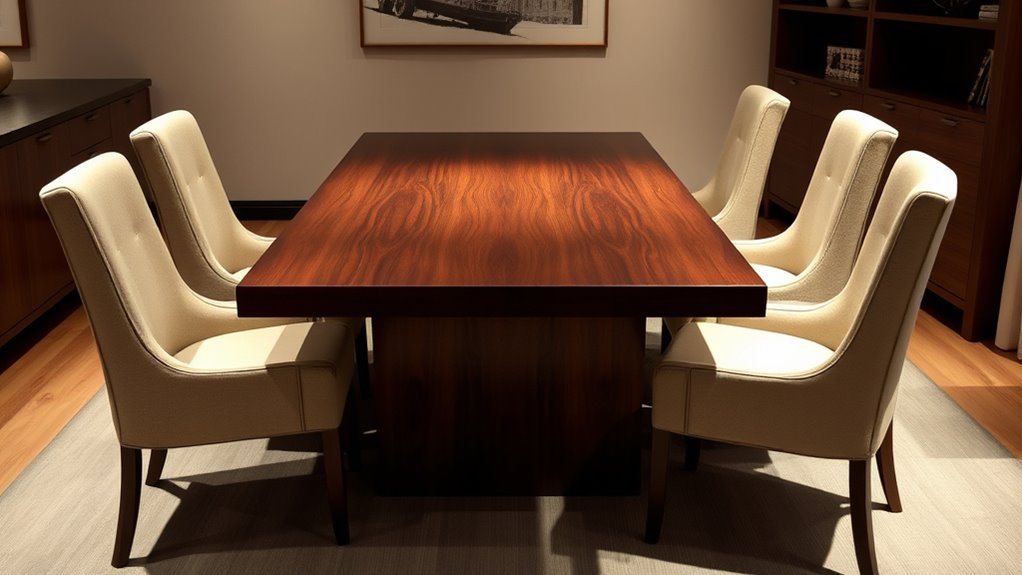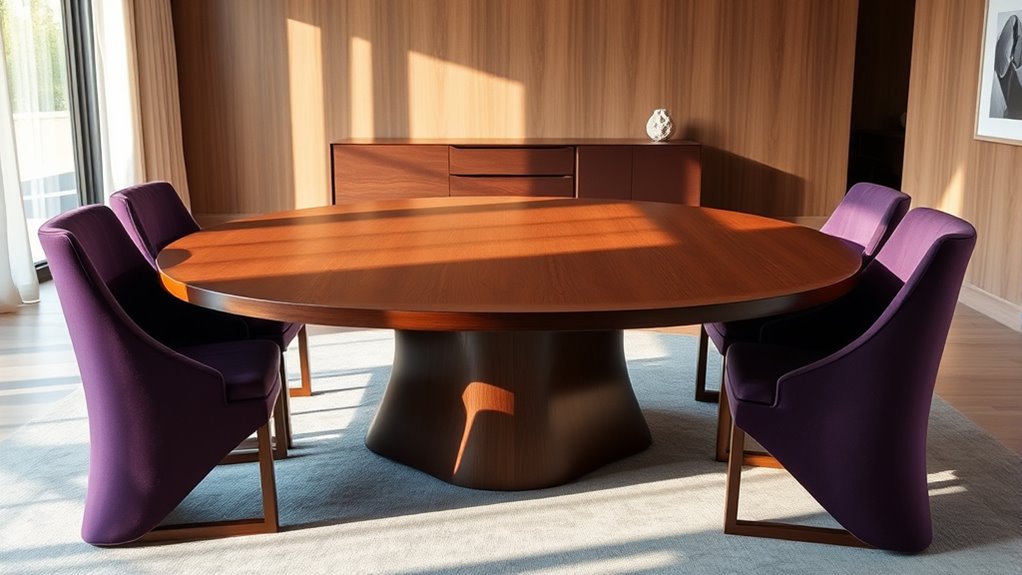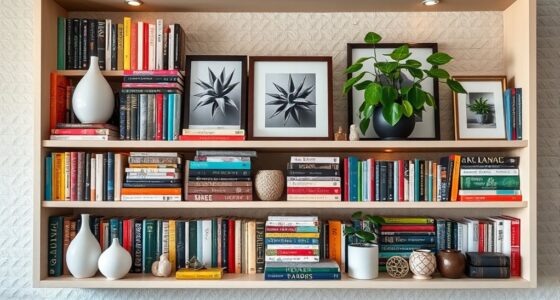To find the right dining table size and shape, first measure your space carefully, leaving at least 36 inches around the table for easy movement. Consider your room’s layout and how many people you plan to serve, choosing shapes like round for intimacy or rectangular for longer rooms. A well-sized table ensures comfort and flow, preventing a cramped feel. Keep exploring for tips on selecting the best shape and size for your space.
Key Takeaways
- Measure your space carefully, leaving at least 36 inches of clearance around the table for comfortable movement.
- Choose table shapes based on room layout: rectangular for long spaces, round for small gatherings, square for compact rooms.
- Opt for adjustable or extendable tables to accommodate varying group sizes without overcrowding.
- Select durable materials suited for daily use and easy maintenance, such as wood, glass, or metal surfaces.
- Ensure the table size fits your space, balancing functionality, aesthetics, and guest comfort for an optimal dining experience.

Choosing the right dining table size and shape is essential to creating a comfortable and functional dining space. When working with small space solutions, selecting the correct table becomes even more critical. You want a piece that fits well without crowding the room while still providing enough space for everyone to dine comfortably. To start, measure your available area carefully. Keep in mind that you should leave at least 36 inches of clearance around the table for easy movement. This way, you avoid a cramped feeling and ensure guests can move freely without knocking into furniture or walls.
Measure carefully and leave at least 36 inches of clearance for a comfortable, well-arranged dining space.
Once you know your space limitations, consider the shape that best suits your needs. Rectangular tables are classic and versatile, fitting well in longer rooms and accommodating larger groups. Round tables foster a more intimate atmosphere and are ideal for smaller gatherings, especially in tighter spaces. Square tables work well in compact rooms and can be pushed against walls when not in use, saving valuable space. Think about how many people you typically host—if you often entertain larger groups, a table that extends with leaves might be a smart investment, offering flexibility while maintaining a small footprint when not extended. Additionally, selecting a table with a durable surface material can help withstand everyday use and spills, especially in busy households.
In small spaces, the shape can make a big difference in functionality. For example, a round table in a compact room can maximize seating without overwhelming the space. It also makes conversation easier since everyone can see each other. Conversely, if your dining area is long and narrow, a rectangular table can make better use of the space. Remember, choosing the right size is just as important; a table that’s too large can dominate the room, while one that’s too small may leave guests feeling cramped. Furthermore, market growth projected at over 40% CAGR in AI tech by 2025 indicates that innovative materials and designs are increasingly available, which can enhance both style and durability of your furniture.
Taking care of your table is also key to maintaining its appearance and longevity. Follow simple table maintenance tips, like regularly cleaning with a damp cloth to prevent buildup of dust and stains, and using coasters or placemats to protect the surface from scratches and heat damage. If your table has a wood finish, apply furniture polish periodically to keep it looking polished and new. For glass or metal tables, check for loose fittings and clean with appropriate solutions to prevent scratches or corrosion.
Additionally, considering your table’s material can influence its durability and maintenance needs, especially in small spaces where furniture may encounter more frequent wear. Ultimately, finding the right dining table size and shape involves balancing your space limitations, your style preferences, and your functional needs. With proper measurements and thoughtful selection, you’ll create a dining area that’s both inviting and practical—one that makes every meal feel special without sacrificing comfort or flow.
Frequently Asked Questions
How Do I Choose a Dining Table for a Small Apartment?
When choosing a dining table for a small apartment, you should focus on space-saving solutions and multifunctional furniture. Opt for a drop-leaf or extendable table that can be compact when not in use. Consider a table with built-in storage or a foldable design to maximize space. These options help you enjoy a functional dining area without sacrificing valuable room, making your small apartment feel more open and versatile.
What Is the Ideal Height for a Dining Table?
Oh, the eternal quest for perfect table height—because who doesn’t dream of ergonomic comfort every meal? The ideal table height is around 28-30 inches, ensuring you’re not hunching or straining. This range balances practicality and comfort, letting you eat, chat, and work without feeling like you’re in a workout session. Keep it within this range for a dining experience that’s both functional and stress-free.
How Do I Select a Table Shape for Different Room Layouts?
When selecting a table shape for different room layouts, focus on table placement and how it complements your space. For smaller or narrow rooms, a rectangular or oval table maximizes seating without crowding. In open, spacious areas, round tables promote conversation and flow. Consider aesthetic considerations like style and proportion to make certain the table enhances your room’s design. Choose a shape that fits your space comfortably while matching your lifestyle and decor.
Can a Dining Table Be Extended for Larger Gatherings?
Yes, you can definitely extend a dining table for larger gatherings. Extendable tables feature table expansion mechanisms that allow you to easily add or remove leaves, providing extra space when needed. These tables are perfect for accommodating guests without sacrificing style or functionality. Just make certain you choose one with sturdy extension mechanisms, so the table remains stable and easy to adjust during your gatherings.
What Materials Are Best for Durable, Long-Lasting Tables?
When choosing materials for durable, long-lasting tables, you want to think about wood finishes that resist scratches and stains. Hardwoods like oak, maple, or walnut are excellent options because they’re sturdy and age well. Remember to follow maintenance tips such as using coasters, cleaning spills promptly, and applying protective finishes regularly. This helps your table stay beautiful and functional for years, ensuring you get the most out of your investment.
Conclusion
Choosing the right dining table size and shape is like finding the perfect dance partner—endeavor to match their rhythm with your space and style. When you pick wisely, your table becomes the heart of your home, inviting conversations and creating memories. Trust your instincts and measure twice. With the right fit, your dining area will flow effortlessly, turning every meal into a harmonious gathering that feels as natural as a well-choreographed dance.









